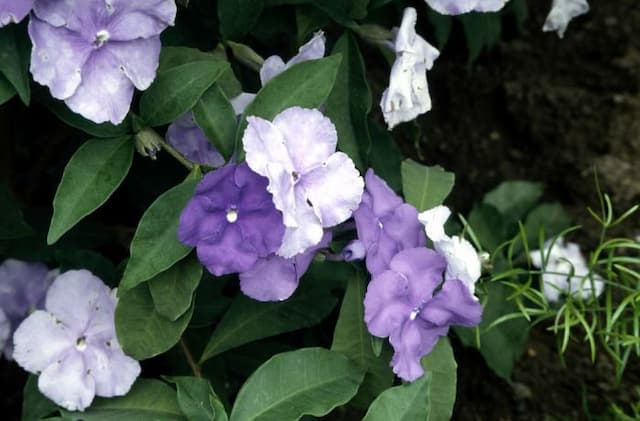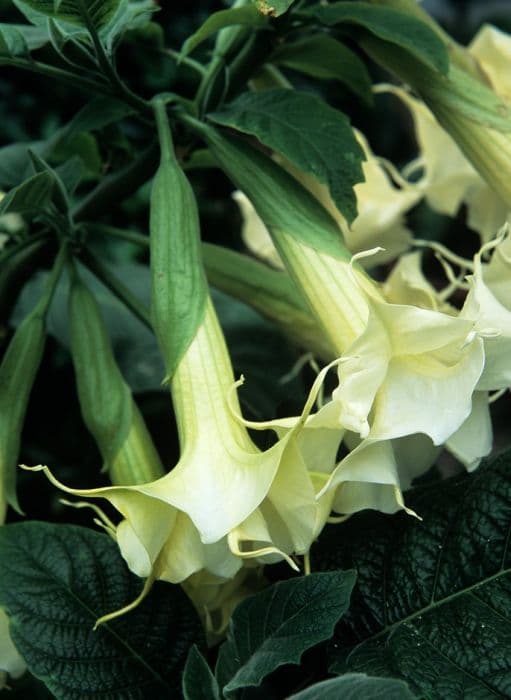Chinese Lantern Physalis alkekengi var. franchetii

ABOUT
The plant commonly known as Chinese lantern features a distinctive appearance primarily characterized by its bright orange to red papery husk, which resembles a lantern in shape and texture, hence its name. Beneath these vivid husks are small, round fruits that are also enclosed by a thin calyx. The green leaves of the Chinese lantern are heart-shaped with pointed tips and exhibit a slightly toothed margin. During its flowering period, which typically occurs in mid-summer, the plant produces small, inconspicuous white flowers that give way to the more notable lantern-like husks in late summer to fall. The overall structure of the Chinese lantern plant is somewhat bushy with multiple stems branching out, providing a full and dense look to the plant. The foliage and husks can persist into winter, offering an enduring visual interest in the garden.
About this plant
 Names
NamesFamily
Solanaceae
Synonyms
Chinese Lantern, Japanese Lantern, Winter Cherry, Bladder Cherry, Strawberry Groundcherry, Franchet's Groundcherry
Common names
Physalis franchetii, Physalis dasyantha, Physalis dasyphylla, Physalis franchetii var. albiflora, Physalis franchetii var. dasyantha, Physalis franchetii var. versicolor, Physalis japonica, Physalis lanceifolia, Physalis linkiana, Physalis longifolia var. franchetii, Physalis peruviana var. franchetii, Physalis pubescens var. franchetii, Physalis versicolor.
 Toxicity
ToxicityTo humans
The Chinese Lantern plant can be toxic when ingested by humans. The unripe fruit, leaves, and other parts of the plant contain solanine, which is a toxic substance. Consumption can lead to symptoms such as vomiting, diarrhea, headache, and stomach pain. In severe cases, it may cause respiratory and circulatory problems. It is important to avoid ingesting any part of the Chinese Lantern plant to prevent these adverse health effects.
To pets
The Chinese Lantern plant is also toxic to pets, particularly dogs and cats. The toxicity is due to solanine present in the plant's unripe fruit, leaves, and other parts. Symptoms of poisoning in pets can include gastrointestinal upset such as vomiting and diarrhea, lethargy, weakness, and in severe cases, respiratory and circulatory distress. It's crucial to ensure that pets do not have access to any part of the Chinese Lantern plant to avoid potential poisoning.
 Characteristics
CharacteristicsLife cycle
Perennials
Foliage type
Deciduous
Color of leaves
Green
Flower color
White
Height
1-2 feet (30-60 cm)
Spread
1-2 feet (30-60 cm)
Plant type
Herb
Hardiness zones
5
Native area
Asia
Benefits
 General Benefits
General Benefits- Ornamental Value: The plant, commonly known as Chinese lantern, has bright orange to red papery husks that resemble lanterns, adding aesthetic appeal to gardens.
- Drought Tolerance: Chinese lantern is known for its ability to withstand dry conditions once established, making it suitable for xeriscaping or low-water gardens.
- Easy Propagation: The plant can be easily propagated through seeds or division, allowing gardeners to expand their collection without additional cost.
- Attracts Pollinators: The flowers of the Chinese lantern attract bees and other pollinators, which are beneficial for the health of the garden ecosystem.
- Seasonal Interest: Chinese lanterns provide visual interest throughout multiple seasons, with flowers in summer and decorative seed husks in autumn.
- Edible Fruit: Although not widely consumed, the fully ripe fruit of the Chinese lantern is edible and can be used in small quantities in various recipes.
- Crafting Material: The husks can be dried and used in floral arrangements or as decorative crafts, especially popular during fall displays and Halloween.
 Medical Properties
Medical Properties- Anti-inflammatory: Physalis alkekengi var. franchetii, commonly known as Chinese lantern, may possess compounds that provide anti-inflammatory effects.
- Diuretic: The plant has been traditionally used for its diuretic properties, which can help promote the production of urine.
- Hepatoprotective: Some studies suggest that extracts of the Chinese lantern plant may offer liver-protecting benefits.
- Expectorant: It has been used in traditional medicine as an expectorant to help clear mucus from the respiratory tract.
- Immunomodulatory: The plant may have effects on the immune system, potentially modulating its activity.
- Antipyretic: Chinese lantern is believed to help reduce fever, acting as an antipyretic agent.
- Antioxidant: Components within the plant may have antioxidant properties, helping to protect cells from oxidative damage.
 Air-purifying Qualities
Air-purifying QualitiesThis plant is not specifically known for air purifying qualities.
 Other Uses
Other Uses- Decorative Lanterns: The bright, inflated calyxes of Chinese lanterns can be dried and used as decorative elements in floral arrangements or as standalone ornaments.
- Jewelry and Accessories: The unique shape of the dried calyxes allows them to be fashioned into earrings, necklaces, or other types of jewelry.
- Festive Decorations: During Halloween and Thanksgiving, the orange color of Chinese lanterns makes them popular for use in wreaths, centerpieces, and other seasonal decor.
- Gift Packaging: The husks of Chinese lanterns can be used to create natural and attractive packaging for small gifts or favors.
- Craft Projects: The dried husks can be used in various craft projects for children and adults, such as making fairy lights or decorating photo frames.
- Floating Lanterns: When used carefully with water, the husks can be turned into miniature floating lanterns for garden ponds and water features.
- Teaching Tools: In educational settings, Chinese lanterns can be used to teach about plant structure, seed dispersal, and life cycles.
- Colorful Mulch: Crushed dried calyxes can be scattered around the base of plants to add a pop of color to garden beds while also serving as organic mulch.
- Art Supplies: Artists may incorporate the textured and colored calyxes into mixed media art pieces or use them as stencils for painting.
- Photography Props: The distinctive silhouette and color of Chinese lanterns make them a popular choice for still life and macro photography.
Interesting Facts
 Feng Shui
Feng ShuiChinese lantern is not used in Feng Shui practice.
 Zodiac Sign Compitability
Zodiac Sign CompitabilityChinese lantern is not used in astrology practice.
 Plant Symbolism
Plant Symbolism- Protection: Also known as Chinese Lantern, Physalis alkekengi's papery husk resembles a lantern, which historically symbolizes protection, as lanterns were used to light the way and guard against spirits.
- Life and Vitality: The vibrant orange color of the Chinese Lantern's fruit is often associated with energy and vitality, as orange can represent enthusiasm and warmth.
- Change and Transformation: The plant's growth from a small flower to a lantern-like husk can symbolize transformation and change, reflecting the idea of personal growth or lifecycle transitions.
- Hidden Talents: With its beautiful fruit hidden inside a husk, the Chinese Lantern can signify hidden talents or inner beauty waiting to be revealed.
 Water
WaterChinese lanterns prefer consistent moisture and should be watered deeply once a week, ensuring water reaches the roots without oversaturating the soil. During hot, dry periods, increase watering frequency to twice a week, providing approximately one gallon of water per plant each time. However, allow the soil to dry out slightly between watering sessions to prevent root rot. Reduce watering in the winter months when the plant is not actively growing, making sure the soil does not become completely dry. Monitoring the top inch of soil for dryness can be a helpful guide for when to water next.
 Light
LightChinese lanterns thrive in full sun to partial shade. Ideally, they should be placed in a spot that receives at least six hours of direct sunlight daily, but can tolerate some afternoon shade, especially in hotter climates. Avoid deep shade, as too little light can lead to weak growth and fewer of the plant's characteristic lanterns.
 Temperature
TemperatureChinese lanterns are hardy in a range of temperatures and can withstand a minimum temperature of around 25 degrees Fahrenheit, though they prefer a much warmer climate for optimal growth. They flourish in temperatures between 60 and 70 degrees Fahrenheit, while high temperatures above 90 degrees Fahrenheit might stress the plant. In areas with cold winters, mulch can be applied to protect the roots from freezing temperatures.
 Pruning
PruningChinese lantern plants should be pruned to remove dead or damaged foliage and to shape the plant, typically done in early spring before new growth starts. Pruning can also help encourage bushier growth and more lanterns. It's often enough to prune once a year, but you can also remove faded lanterns throughout the growing season to keep the plant looking tidy. After the first frost, the above-ground part of the plant can be cut back as it dies back naturally.
 Cleaning
CleaningAs needed
 Soil
SoilChinese lanterns prefer well-draining soil rich in organic matter with a pH range of 5.5 to 7. For the best soil mix, combine two parts garden soil, one part peat moss, and one part perlite or sand. This blend ensures adequate drainage and fertility for healthy growth.
 Repotting
RepottingChinese lanterns should be repotted every 2 to 3 years or when the plant outgrows its current pot. This timing will help manage their vigorous root system and maintain healthy growth.
 Humidity & Misting
Humidity & MistingChinese lanterns are adaptable to a wide range of humidity levels but perform best in moderate conditions. They do not require high humidity and can thrive in the average humidity found in most homes.
 Suitable locations
Suitable locationsIndoor
Place Chinese lanterns in bright, indirect light indoors.
Outdoor
Plant Chinese lanterns in partial shade, well-draining soil outdoors.
Hardiness zone
3-9 USDA
 Life cycle
Life cyclePhysalis alkekengi var. franchetii, commonly known as Chinese lantern, begins its life as a seed, which requires well-drained soil and warmth to germinate. Upon germination, seedlings emerge and the plant enters a vegetative state, during which it develops roots, stems, and leaves to gather sunlight and nutrients. The plant then matures and produces distinctive white to pale pink flowers, usually starting in the summer. Following pollination, these flowers give way to the characteristic lantern-like papery husks which start out green but become bright orange to red at maturity, encapsulating the small, fleshy fruit inside. Fruits ripen and seeds develop within the berries, which can be dispersed by animals or human activity to begin the cycle anew. In winter, the above-ground parts of the plant die back, but the plant can regenerate from its perennial root system in the following spring.
 Propogation
PropogationPropogation time
Spring-summer
Chinese lanterns, also known as Physalis alkekengi var. franchetii, are typically propagated by seed. The best time to sow seeds is in spring, after the last frost has passed, ensuring a warm enough soil temperature for germination. The seeds should be planted in well-draining soil, about 1/4 inch deep, and spaced adequately to allow room for growth. Once sown, seeds typically germinate within two to three weeks. The seedlings can then be transplanted to their final location when they are large enough to handle and the threat of frost has passed. This plant can also be propagated by dividing the roots in early spring or fall, but seed propagation remains the most popular method due to its simplicity and effectiveness.






![Calibrachoa [Callie Mango]](/_next/image?url=https%3A%2F%2Fplants-admin.emdemapps.com%2Fimages%2Fplants%2F%2Fimages%2F604b6514b1579.png&w=640&q=75)


